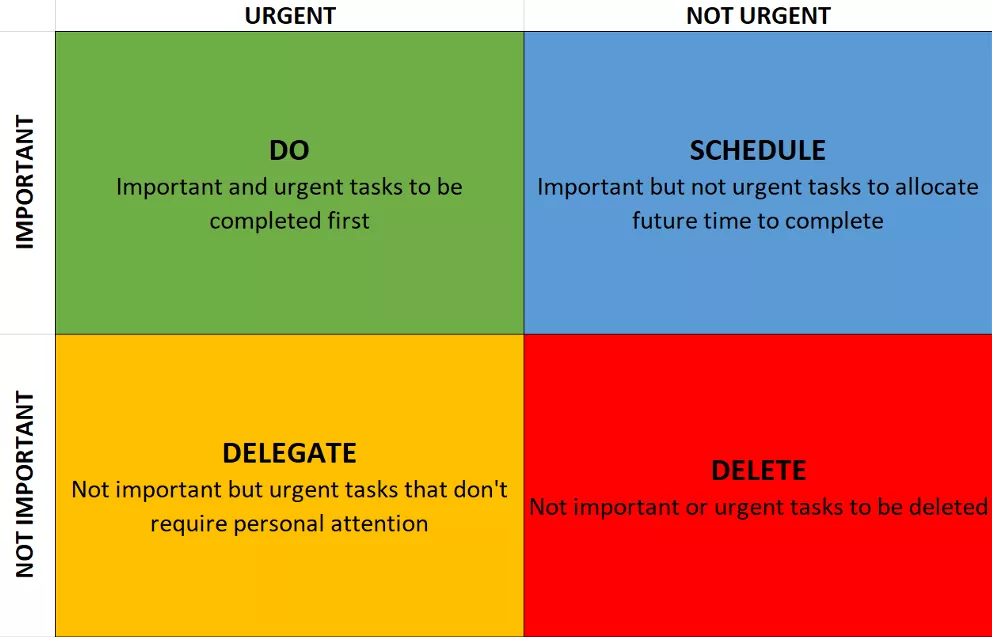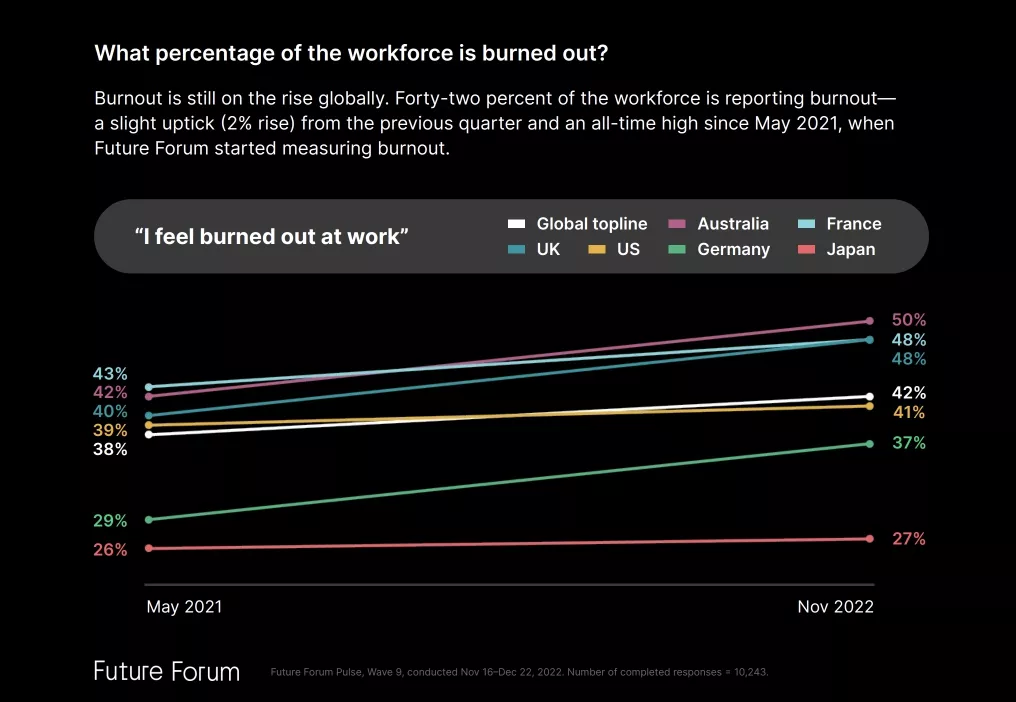How to Deal with Overload at Work – Tips and Effective Tools to Use
Do you find yourself working long hours, from morning to night, in a dense flow of tasks? You may want to improve the situation but find yourself struggling – you need time to automate tasks or even sort them out, but you don’t have it! Your workflow is akin to a situation where you need to sharpen your axe to keep chopping, but there is no time to sharpen it, so you keep chopping with a dull blade.
In this article, I’m going to give you some life-enhancing tips to help you cope with an overload of work and avoid burning out at the workplace.
What causes overload at work?
The first step is to understand the root of the problem. During an internal training session at Netpeak Agencies Group, employees shared their ideas. They came up with a list of factors that can hinder efficiency.
- Organizational management problems:
- Lack of clear objectives and undefined business processes.
- Lack of structure in the team and lack of PMs or supportive team leaders.
- Lack of communication between departments, leading to delays in resolving tasks.
- Inadequate culture of prioritization and refusal to take on tasks outside one’s area of responsibility.
- Lack of clear lines of responsibility.
- Lack of prioritization by management.
- Artificial shortening of deadlines in the tasking process.
- Personal skills and time management:
- Inability to delegate tasks.
- Hyper-responsibility and difficulty saying no to tasks outside your area of responsibility or beyond your timeframe.
- Constant switching between multiple projects.
- Difficulties setting boundaries and resting after work, and accumulation of fatigue.
- Resource constraints and pressures:
- Not enough people in the team.
- More tasks than working hours.
- Complex and urgent tasks, or unexpected events (force majeure).
- Development and training:
- Lack of training leads to reinventing the wheel when there are ready-made solutions.
You can add your own thoughts to this list. Keep the issues divided into four groups, as this will help guide you toward areas for improvement and specific solutions.
What are some methods of coping with overload?
Let’s move on to the question that probably concerns you the most – what can be done to deal with work overload? My colleagues and I have come up with a number of solutions, of which I will mention the most important ones.
- Manage tasks and priorities.
This is, for example, a simple and time-tested method of allocating tasks according to the Eisenhower matrix:
Other tips related to prioritizing tasks:
- Work through the backlog of tasks, and perform regular grooming meetings (meetings where future tasks are sorted out).
- Monitor task relevance (if a task is no longer relevant, it is removed).
- Set and adjust deadlines.
- Define Key Performance Indicators (KPIs) for tasks, projects, etc.
- Organize and plan your work.
This includes careful task planning and delegation, personal time management, etc.
- Separate your work life from your private life.
Here, it is important to be able to switch between work and private life in a qualitative way and to set clear limits on working hours. It is also important that the culture of the company where you work supports timely breaks and complete rest for employees.
- Conduct employee training and development.
It is worth introducing mentoring and knowledge sharing within the team, as well as regular training and the like. This will improve team members’ abilities and therefore naturally reduce heavy workloads.
- Process optimization.
Work processes should be simplified and automated as much as possible.
It’s clear that solutions to overwork exist and are known to most managers. So why do companies still experience overwork and overtime? There are several reasons.
- Failure to communicate the value of measures to prevent overload to the person who expects the team to deliver results.
- As a result, the team doesn’t allocate the time and resources to identify the factors leading to overload and fails to correct the situation in a timely manner.
- Employees are then focused on managing the pipeline of tasks rather than optimizing it.
- Because of the overall team overload, subtle changes at the individual employee level do not resolve the situation.
If it happens regularly, work overload can lead to several issues, including chronic fatigue, stress, loss of creativity, and burnout. According to Future Forum data for 2023, 42% of the world’s office workers suffer from burnout.
Source – Future Forum report, 2023
How can you help yourself cope with the increasing flow of tasks, regardless of your position as a CEO, team leader, or ordinary employee?
What is the GTD method, and how do you apply it?
Certain areas of time management are based on the idea that it is possible to manage time. But is it truly possible to manage time? I would like to introduce you to David Allen’s Getting Things Done (GTD) concept, which states that a person cannot manage time, but they can manage their attention.
Attention is the new gold of the modern world, and social media, mass media, and advertisers are all competing for people’s attention.
It is difficult to orient oneself in the unbelievable volume of information flow. At the same time, the human being remains, first and foremost, a biological organism: when a new piece of information arrives, our brain still automatically decides whether to forget or remember it.
Allen offers a unique approach to organization and task management to help you structure your daily and long-term goals, reduce stress, and increase productivity. The principles apply to both professional and personal life.
- Capture everything that has your attention.
Start by documenting all the tasks, ideas, and commitments that come to mind. This allows you to “clear” your mind and relieve it of the need to remember every detail.
This stage is similar to a to-do basket. You have yet to decide, and you’re just committing to a Google Calendar, Notion, or a notebook.
- Clarify what needs to be done.
At this stage, make a simple analysis of all your tasks and categorize them into two groups: those that require immediate action and those that can be postponed until tomorrow or later. Some tasks should be delegated or discarded altogether.
Life hack: If a task takes two to five minutes to complete, such as writing a message, making a phone call, or the like, don’t write it down or put it off. Do it right away.
- Organize information so that you can find it later.
Group your tasks into categories or projects, and organize those by priority levels.
Life hack: For all incoming work, you should note what you will and when you will do it (first steps). It’s enough to write a summary and specify the period in Google Calendar.
- Reflect and prioritize your work.
Review tasks and projects regularly to evaluate the progress and relevance of the list. Some tasks may lose their priority and should be removed from the list in time. Making progress on other tasks will be a nice form of motivation for your mind :)
- Engage with the tasks next.
Now, it is time to execute the tasks assigned for the current moment, taking into account your skills and priorities. Nothing is more inspiring than a completed task crossed off a sprint or diary.
Life hack: The popular Tomato Method or Pomodoro Technique – a technique for managing your performance proposed by Francesco Cirillo in the 80s of the 20th century – will help here. It is essentially the 25/5 method, comprising 25 minutes of complete immersion in the task and then a short 5-minute break for tea or coffee.
The tomato method is very much tied to the biology of our brains, which find it difficult to be focused on one task for more than 25-30 minutes. Therefore, you can change the time to suit your needs, but you should not extend the active time too much.
Conclusions
In general, work overload occurs due to four main issues. These are organizational and leadership problems, poor work organization and planning, resource constraints and workload, and a lack of training.
There are many ways to address the problem of work overload, ranging from time management to the implementation of personal effectiveness. One particularly effective way is David Allen’s Getting Things Done (GTD) method. It is based on the idea that a person cannot control time, they can only manage their attention. Therefore, it is important not to clutter your mental space.
Through the GTD method, each task goes through five stages. Following these steps will help you get started and see your actions through to completion.
- Capture.
- Clarify.
- Organize.
- Reflect.
- Engage.
Related Articles
How to Set Up Consent Mode in GA4 on Your Website with Google Tag Manager
Let's explore how to properly integrate consent mode in GA4, configure it for effective data collection, and at the same time comply with GDPR and other legal regulations
Display Advertising Effectiveness Analysis: A Comprehensive Approach to Measuring Its Impact
In this article, I will explain why you shouldn’t underestimate display advertising and how to analyze its impact using Google Analytics 4
Generative Engine Optimization: What Businesses Get From Ranking in SearchGPT
Companies that master SearchGPT SEO and generative engine optimization will capture high-intent traffic from users seeking direct, authoritative answers




